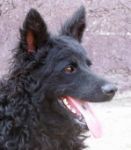Buco
Site Admin

Pridružen/a: 24. 05. 2008.
Postovi: 254
|
 Postano: sub kol 06, 2011 4:56 pm Naslov: Blood groups, haematology and clinicochemical indicators Postano: sub kol 06, 2011 4:56 pm Naslov: Blood groups, haematology and clinicochemical indicators |
 |
|
Veterinarski Arhiv 78 (2), 141-147, 2008
Blood groups, haematology and clinicochemical indicators in
indigenous breeds of dog. I. Croatian sheepdog
Damir Žubčić1*, Ljiljana Bedrica1, Damjan Gračner1, Ivica Harapin1,
Mijo Fury2, and Jasna Jeremić3
1Clinic for Internal Diseases, Faculty of Veterinary Medicine, University of Zagreb, Zagreb, Croatia
2Veterinary Station Županja
3State Institute for Nature Protection, Zagreb, Croatia
ŽUBČIĆ,
ABSTRACT
The research involved 95 pure breed Croatian sheepdogs, 48 females and 47 males ranging in age from 1 to
12 years. Blood samples were taken to establish certain biochemical indicators (urea, creatinine, total proteins,
glucose, total bilirubin, AST, ALT, alkaline phosphatase, creatine kinase, amylase, Ca, P). No changes were
observed through comparison of average values. Blood samples of 30 dogs, from that group, also were taken to
establish blood group DEA (Dog Erythrocyte Antigen) 1.1. and standard haemogram. In 27 dogs (90.0%) the
blood group DEA 1.1., was found, which is a significantly higher percentage than in all investigations to date. It
was observed that the average values of all haematological indicators were within physiological parameters.
Key words: blood group, Croatian sheepdog, haemogram, biochemical indicators
Introduction
The Croatian sheepdog is an indigenous Croatian dog, and according to credible data,
was bred and used by Croatian tribes in their former historical homeland, and brought
with them to their new homeland some 13 centuries ago. This animal has proved to be an
exceptionally useful working dog, not only with sheep but with all animals found in rural
homesteads (Rohr, 1960).
As the thousand-year tradition of extensive livestock breeding is rapidly giving way
to intensive breeding, the Croatian sheepdog is losing its primary role. Increasingly, the
dog is moving from its natural habitat into urban environments, which inevitably leads to changes - as in its function so, consequently, in its physical and psychological constitution
(ROHR, 1950; ROHR, 1953; ROHR, 1954; ORBAN, 1958). Some authors (ROMIĆ, 1977;
FURY, 2002) have researched certain biochemical, diagnostically significant parameters in
the blood serum of the Croatian sheepdog found in the areas of Đakovo and Županja. Our
efforts have focussed on expanding this research to establishing blood groups, something
that has not been undertaken in Croatia to date.
The available literature tells us that the haematological and biochemical values in
blood of various breeds are not dissimilar to blood groups in individual breeds. However,
certain differences do exist.
So far only ROMIĆ (1977) has set haematological parameters for Croatian sheepdog.
Some of the biochemical indicators in the blood serum of Croatian sheepdog have been
defined by FURY (2002).
Eleven different blood groups comprising eight types (FELDMAN, 1993) have been
identified in dogs. Initially, blood groups were designated by letters (Am B, C, D, E, F, G,
K, L, M, N, Tr, o, He), but today blood groups in dogs are designated by the DEA system
(Dog Erythrocyte Antigen) - DEA 1 to DEA 8 (KOHN et al., 1998; FELDMAN, 1993).
Blood group DEA 1 has two sub-groups: DEA 1.1. and DEA 1.2. (KOHN et al., 1998).
Swisher and YOUNG (1961) determined the percentage of blood group DEA 1.1. in 332
cross-breeds, arriving at 44.6%. SWISHER et al. (1973) established the presence of blood
group DEA 1.1. in 40% of tested dogs. SUZUKI et al. (1975) tested 61 dogs and established
that 36% of them possessed blood group DEA 1.1. The percentage of the same DEA 1.1.
blood group investigated by WRIESENDORP et al. (1976) was 37% in cross-breeds, 43.4%
in beagles and 29% in retrievers. EJIMA et al. (1986) tested 224 dogs in order to establish
blood groups and found that 33% had the same blood group. Two-thirds of dogs tested
were mongrels. KOHN et al., (1998) tested a group of 88 dogs and found that 52% of them
also had blood group DEA 1.1.
GIGER et al. (1995), and KOHN et al. (1998), offer an interesting item of information,
whereby the variations in the percentage of blood group DEA 1.1. could be due to
geographical differences.
Materials and methods
Blood samples from 95 adult Croatian sheepdogs: 48 females and 47 males ranging
from 1 to 12 years of age were taken to establish biochemical profiles in serum for kidneys
(urea, creatinine), liver (total proteins, total bilirubin, AST - aspartate aminotransferase,
ALT - alanine aminotransferase), pancreas (glucose in blood, amylase), bones (calcium,
phosphorus, alkaline phosphatase) and muscles (creatine kinase).
Research on blood groups and haematology involved 30 pure-bred Croatian
sheepdogs: 21 females and 9 males ranging from 2 to 12 years of age.
All dogs had blood samples taken from the blood vessel v. cephalica antebrachii into
sub-pressurised tests tubes containing anticoagulant in order to perform a complete blood
test and to establish blood groups.
... |
|

